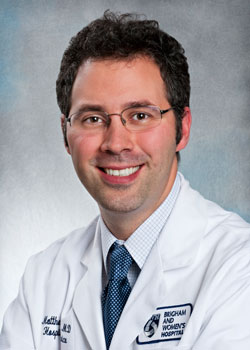Clinical Documentation Improvement Moving
Forward

Matthew Vitale, MD |
One
of the most basic, yet essential ways BWH and BWFH are working to meet their
patient affordability goals is to ensure that the hospitals are reimbursed
correctly for patient care. It sounds simple, but there are many complexities
in the clinical documentation process that can prevent the hospitals, their
clinics and diagnostic and procedural areas from receiving adequate
reimbursement.
Hospitals are paid a single, predetermined sum based on a patient's diagnosis-related group (DRG). A medical coder
analyzes the clinical statements
related to a patient's care and assigns standard codes using the DRG
classification system to submit payment requests.
If
certain boxes on the clinical forms are overlooked, it could cost the hospital
thousands of dollars in reimbursement. Coders, who don't have clinical
training, rely on physicians to thoroughly and accurately complete the
documentation.
"The
documentation must be accurate and detailed so that a coder can code properly,"
said Sharon Vitti, vice president of Women's Health and Ambulatory Services and
executive sponsor of the CDI program. "Making sure our documentation is as
complete as possible is also essential to patient care; it strengthens hand-off
communications and outcomes data that we collect."
Under
the Patient Affordability umbrella in the hospitals' strategic commitments, BWH
and BWFH have put in place a Clinical Documentation Improvement (CDI) program
to ensure documentation is accurate. At the hospitals, eight nurses are responsible
for augmenting the coding process by reviewing clinical documentation for
Medicare patients before it goes to medical coders. The nurses work with
physicians and residents to ask the right questions about the patients'
conditions to ensure that documentation is thorough before submission.
"For
example, if you check ‘pneumonia' in the documentation, but you leave out
critical information about other conditions we are treating the patient for,
that can cost us about $30,000 to $40,000 that otherwise would have been
reimbursed," said Vitti. "That is significant. We now go through this process
for every Medicare patient who receives care here."
Though
documentation improvement has been ongoing for more than 10 years, it was
redesigned and reintroduced as the CDI program in October 2011. In early 2012, Matthew Vitale, MD,
and Andrea
Kelly, JD, RN, were appointed
medical director and program director, respectively, to lead and oversee the
efforts.
Vitale, who is associate director of the BWH Hospitalist
Service, coordinates with medical
staff to provide education and increase awareness about the need for
comprehensive quality medical record documentation. He also provides clinical
guidance and support to non-medical staff as part of the role.
"I try to think about the questions I would have looking at a
patient's medical chart from a coder's perspective," said Vitale. "In terms of
the bigger picture, I speak with physicians about what this program is and how
it ties into the clinical work they're doing."
"We provide very high quality clinical care here, and sometimes
documentation tasks are harder for people to get excited about," Vitale added.
"But so much builds off of the documentation we produce, so I want to educate
physicians about Medicare-specific language and support them in their practice.
The goal is to capture who our patients are, and to do that, we have to use the
right words and check the right boxes."
As
CDI program director, Kelly provides daily oversight of the CDI team of nurses
at BWH and BWFH, ensuring accurate and timely clinical documentation in the
medical record.
"The insight of our nurses, who review and relay the
complexities of patients' medical date, is crucial to CDI's effectiveness," she
said. "We hope to keep moving forward and sharing the program's goals with care
providers."